Civilizations were formed throughout history, at different stages and places. This timeline of ancient civilizations will help you understand how historical societies and empires developed in the world, some of them in Europe others in Asia, Africa and the Americas.
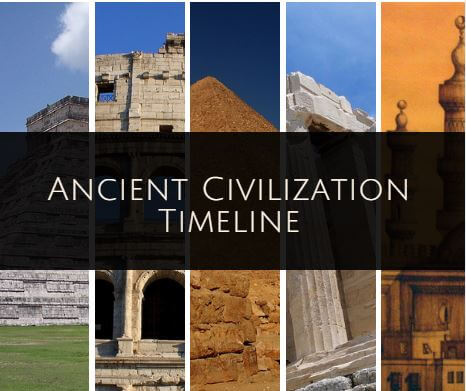
Timeline of Ancient Civilizations in Asia
Contents
China – Ancient Chinese Civilization
Ancient Era

The existence of written documents from long ago has allowed the development in China of precise historiographical tradition that offers a continuous narration from the first dynasties to the contemporary age.
2100-1600 BC
The First Chinese Dynasty, Xia, was a slavery-based society that allowed private property. In this period, the first Chinese calendar was produced. It divided the year into 12 months and determined the agricultural and political activities for each month.
1600-1045 BC
The Shang Dynasty. The kings of this dynasty practiced the art of prophecy. They started to use currency. They had a class system with aristocrats and plebeians.
1045-256 BC
Zhou Dynasty. In addition to the aristocrats and plebeians, they added the slave class. They made delicate carvings into jade, works with bronze and woven silk. In this period, they developed horse-driven war chariots. They worshiped their ancestors, practicing human sacrifice and live burial of slaves with their masters. They used more than 3000 symbols that were transformed into the characters used in the Chinese language. The use of money was strengthened while bartering decreased in use. This was the era of great thinkers and philosophers like Confucius and Lao Tzu.
Imperial Era
221-206 BC
Qin Dynasty. The title of king was changed to Emperor. This was the first dynasty of reunified China, which was much larger than when it was under the Zhou Dynasty. A strong, unified, and centralized Chinese state emerged. They carried out an intense unification of norms: weights and measurements as well as the system of writing were all unified.
206 BC-220 AD
Han Dynasty. Established by Liu Bang. Agriculture, industry, and trade flourished. Education and writing, on the recently developed rice paper, were both encouraged. They also promoted the interchange of merchants through the silk route. The population became 50 million.
265-420 AD
Jin Dynasty. They successfully reunified China after the period of the three kingdoms. In 311 AD and 316 AD, the nomads of the north conquered Northern China, and the Jin Dynasty governed the south until 420 AD.
581 AD- 618 AD
The Sui Dynasty brought the reunification of the south and the north, The Grand Canal was constructed and extended the Great Wall of China.
1279 AD
The Mongolian conquest of China ended. The Mongols were a nomadic tribe from the north.
Mongol Civilization

The Mongol empire was the most extensive in history. In its prime, it extended from the Korean peninsula to the Danube river.
Established by Genghis Khan, the empire came to occupy and maximum extension of some 33 million square kilometers and more than 100 million inhabitants, including some of the most advanced and populated nations of the time, like China, Iraq, Iran, and countries of Central Asia and Asia Minor.
1206 AD
The warrior Temudjin united all the Mongolian tribes under his command when he was declared Great Khan, with the name Genghis Khan. Immediately after, he attacked the provinces of Northern China and Eastern Persia and penetrated Southern Russia and the Caucasus. Under mandate from Genghis Khan, all citizens (always, even when they were nomads) and the religious people were considered equal by the Mongolian law, meanwhile the overweight population and the Chinese especially were discriminated against.
1227 AD
During the wars in Western China, Genghis Khan died from illness.
1229 AD- 1241 AD
With the reign of Ogodei, the conquest of the Jin Dynasty in China and the conquest in Persia were completed. He also started a siege on Europe with an overwhelming drive. Only the death of the ruler would cause the Mongolian army to withdraw.
1235 AD
The Great Khan Ogodei entered a conflict with the Song Dynasty. The war ended 45 years later with complete occupation of the Chinese territory.
1208 AD – 1259 AD
Mongke Khan, the fourth Great Khan, was responsible for the Mongolian invasion of Russia and Eastern Europe.
The tribal rivalry, the assimilation of conquered cultures, the ancient military model, the development of agriculture, the absence of an effective military, and the use of gunpowder were some of the most important factors in the decay of the Mongolian empire.
Assyria .– Ancient Assiryan Civilization
Assyria was a country of antiquity situated in Southeastern Asia in ancient Mesopotamia, in the valley of the Tigris river whose limits were: the northern Armenian mountains, the Chaldeans (Babylonians) to the south, and to the east, the center, and the west, Mesopotamia.

The most important city was found on the banks of the Tigris river, next to the temple of their first god Assur; the city was also called Assur or El-Assur and the country took the same name, Assyria. Other important cities were Nineveh, Harran, Calakh, Dur Sharrukin (now called Khorsabad).
1900 BC
Groups of Assyrian merchants formed colonies in Anatolia (modern center of Turkey) and there they established a prosperous metal and textile trade.
1813 BC – 1780 BC
Assyria became an empire
1760 BC
Hammurabi broke down and conquered the Assyrians that would go on to form part of the Babylonian empire.
1318 BC – 1050 BC
The Assyrian empire became the first great military empire of Mesopotamia.
700 BC
The Egyptian Conquest
609 BC
The Medes and Babylonians took Harran, finally ending the Assyrian empire.
Turkey

Due to their strategic position, unifying Europe and Asia and lying between 3 seas, Turkey has been a historic mixing of western and eastern cultures and civilizations. It has been the home of various, powerful civilizations and the location in which many battles between them took place throughout history.
Anatolia is a peninsula located in the Middle East, occupied today by the Asian part of Turkey.
Anatolia, that contains the greater part of modern-day Turkey, is one of the oldest and continuously inhabited regions in the world. In Ancient Greece, Anatolia was known as Asia to the west of the peninsula, extending later to the name of the whole continent. Thus, the peninsula is called Asia Minor. For being a mountainous region, it has historically been a military stronghold for several peoples. Including Troy, The Hittites, The Kingdoms of Phrygia, Lydia, the Byzantine empire, and the Ottoman empire; also, Greek people, Turks, Seleucids, Syrians, and a small part of Rome have occupied this region.
In this peninsula, the famous Battle of Troy took place, in which the Greeks, led by Agamemnon, won against the Trojans, led by Hector.
1700 BC – 1100 BC
The Hittites inhabited the region of Anatolia Pre-Turkey
1200 BC
Greeks populated the west coast of Anatolia.
6th-5th century BC
The Persian empire conquered the entire area.
334 BC
Alexander the Great conquered the region
100 BC – 0 AD
The territory succumbed to Rome
324 AD
The Roman Emperor, Constantine I, selected Byzantium as the new capital of the Roman empire (Greek city, capital of Thrace, located at the entrance of the Bosphorus Strait, part of modern day Istanbul, and who has occupied a prominent location in history since its establishment).
Timeline of Ancient Civilizations in Africa
Egypt – Ancient Egyptian Civilization
7000 BC
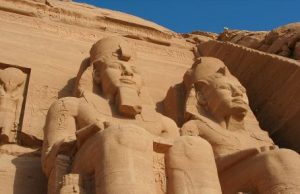
There is evidence of pastoral life and cultivation of grain in the Eastern Sahara.
6000 BC
Organized agriculture appears along with the construction of great cities.
5500 BC – 3100 BC
During the Pre-Dynastic period, the small settlements prospered along the Nile River.
3300 BC
Egypt was divided into two kingdoms, known has Upper Egypt and Lower Egypt. The frontier between both was in modern-day Cairo, south of the Nile Delta.
3500 BC
The first acts of canalization and Hieroglyphic writing emerges.
3200 BC – 3100 BC
Proto-Dynastic period: In this period, the first authentic cities emerged. Vases carved from stone, knives, ceremonial blades, and dedicated scepter heads.
3100 BC – 2700 BC
Archaic Kingdom: Menes, the first Pharaoh of Ancient Egypt, unified Upper and Lower Egypt.
2700 BC – 2250 BC
Ancient Kingdom. Memphis is established as the capital. During this period, the custom of building great pyramids began. The V Dynasty marked the ascent of the high priest.
2250 BC – 2050 BC
First Intermediate Period: Literature flourished in this period. The growth of the middle class created a new conception of belief that was reflected in the appearance of the so-called Texts of the Sarcophagi.
2050 BC – 1800 BC
Middle Kingdom: Period of great economic prosperity and outward expansion. Ambitious irrigation projects in Faiyum were completed to regulate the flooding of the Nile River, diverting it toward Lake Moeris. The Hyksos conquered Egypt, causing the fall of the Middle Period.
1800 BC – 1550 BC
Second Intermediate Period: Under the rule of the Hyksos, the city of Avaris acted as a capital city until the Egyptian leaders of Thebes declared the “Salvation of Egypt” and declared a “Salvation War” against the Hyksos.
1550 BC – 1070 BC
New Kingdom: In the outward expansion arrived at the Euphrates (Asia) as well as to Nubia (Africa). In the end, they faced invasions from the People of the Sea, people from the Aegean Sea and Libya.
1070 BC – 656 BC
Third Intermediate Period: 2 Libyan dynasties were established that divided Egypt.
656 BC – 332 BC
Late Period: With two periods of Persian rule, Egypt became a Satrap (protector of the land/country).
332 BC – 30 BC
Hellenistic Period: Started with the conquests of Alexander the Great from Macedonia and ended with the incorporation of Egypt into the Roman empire through the Battle of Actium. In the year 30 Bc, Cleopatra died.
30 BC – 640 AD
In the year 30 BC Alexander Octavio came around, making Egypt a Roman province. Egypt was passed to the Byzantines when the Roman empire was divided until the Arabic conquest in the year 640 AD
Ancient Civilizations in the Middle East
The Ancient Near East or Ancient East is the term used to denote the areas of Western Asia and North East Africa where the civilizations arose before the classic Greco-Roman civilizations in the area currently called the Near East or Middle East. This is the region where the first Neolithic Revolution arose (8th century BC) and later, the Urban Revolution (4th Century BC). Modern day Iraq, part of Iran, part of Turkey, Syria, Lebanon, Israel, the Palestinian Territories, Jordan, Arabia, and Egypt lie in the Middle East.
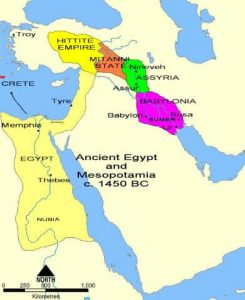
For this period, three chronologies are traditionally handled differently, known as “high”, “middle”, and “low”. The difference between these chronologies is owed to the ambiguity in the sources, mainly the Venus Tablet.
2600 BC – 2500 BC
In Iraq, Bactrian camels and dromedary camels are domesticated.
2500 BC – 2400 BC
The Phoenicians establish themselves on the coasts of Syria and Libya, coming from Arabia in the 4th century BC.
In Pakistan, a civilization developed in the Indus Valley
1800 BC – 1700 BC
This century was marked by the ascent (in 1792 BC) of Hammurabi to the throne of Babylonia. He later started a political expansion.
1792 BC
Hammurabi started his kingdom. He changed Babylonia into a center of trade in the Middle East.
1761 BC
Hammurabi conquered the city of Larsa and declared himself emperor.
1760 BC
Hammurabi wrote an important collection of laws designed to guarantee equality of the judicial system of his time. It is known as the Hammurabi Code.
1750 BC
The reign of Hammurabi ended.
1146 BC
Nebuchadnezzar became the King of Babylonia.
628 BC
The prophet Zarathustra is born. (Zoroastrianism)
600 BC
Nebuchadnezzar II constructs the Hanging Gardens of Babylonia.
587 BC
The Babylonians take Jerusalem. They make Zedekiah king of Jerusalem. They destroy the temple of Jerusalem.
555 BC – 529 BC
Cyrus the Great conquered the Medes, defeated Babylonia, Syria, Palestine, and Asia Minor.
530 BC – 522 BC
Cambyses II, son of Cyrus the Great, conquered everything up to modern-day Afghanistan.
634 AD
The Arabs, recently converted to Islam, take Ctesiphon (Modern Iraq).
655 AD
The Arabs conquered what is currently Afghanistan.
750 AD
The Abbasids, descendants of Abbas, uncle of Muhammad, were established with the power of the Caliphate and moved the capital from Damascus (Syria) to Baghdad (Iraq).
1040 AD
The Turks take control of modern-day Iran and Iraq.
1220 AD
Persia was conquered by Genghis Khan.
Medes (Near East or Middle East)
They were nomads with livestock that spoke some sort of Indo-Iranian language and during the first millennium they were divided into various small tribes.
Despite that the borders of the Medes were never perfectly fixed, their territory corresponded to modern-day North East Iran. The country was, and continues to be, dominated by the East-West road known as the Silk Road in the Middle Ages. This road connected the Medes with Babylonia, Assyria, Armenia, and the Mediterranean Sea in the West, and with Parthia, Arya, Bactria, Sogdiana, and China in the East. Another important road united the capitals of Persis, Persepolis, and Pasargadae.
The Medes controlled the East-West trade, but they also were rich in agricultural production. The Greek Author, Polybius of Megalopolis, correctly called the Medes the most powerful of the Asian countries. The Medes were recognized generally as an important part of the Seleucid and Persian Empire.
701 BC
Deioces successfully unified the Median empire as a measure to protect against the Assyrians.
614 BC
Astyages, in alliance with the Babylonian Nabopolassar, conquered Nineveh and thus ended the Assyrian empire.
553 BC
Cyrus II “The Great” conquered the Median empire, which formed part of the Persian empire.
Persia – Ancient Persian Civilization
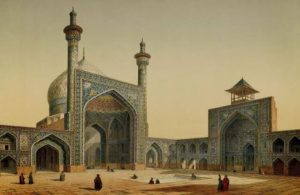
The Achaemenid empire, or The Persian Achaemenid empire, is the name given to the first and more extensive Persian empire, which was extended by the territories of modern-day Iran, Iraq, Turkmenistan, Afghanistan, Uzbekistan, Turkey, Cyprus, Syria, Lebanon, Israel, and Egypt. Its territorial expansion started during the reign of Cyrus II (559 BC – 530 BC), with the annexation of the Median kingdom. The Achaemenid empire reached its height in the year 500 BC when it started to encompass the parts of modern-day Libya, Greece, Bulgaria, and Pakistan, as well as certain areas of Caucasus, Sudan, and Central Asia.
The Persians belonged to Iranian groups that had been established centuries before in the plateau of Iran. They were dedicated to cattle-raising but with time they adopted agriculture.
The Persians of early times were subjects of their powerful neighbors, the Medes.
553 BC – 550 BC
Cyrus defeats the Mede king Astyages, ending the Median rule in the Iranian plateau.
540 BC
Cyrus “The Great” conquered the kingdom of Lidia (modern-day Turkish province) in Asia Minor.
539 BC
Cyrus conquered Babylonia and presented himself as the savior of the conquered nations. He protected the cultures and restored the temples in the newly acquired cities.
530 BC
Cyrus dies.
521 BC
Darius is declared king.
518 BC
Darius founded Persepolis. Thrace (Modern-day Bulgaria, Greece, and Turkey) and India were annexed.
490 BC
The Greeks in the Medic Wars (Battle of Marathon) stopped their advances.
424 BC – 404 BC
Darius II collaborated with Sparta in the Peloponnesian Wars and defeated Athens.
64The Egyptians are freed from the Persians with the conquests of Alexander the Great.
330 BC
The Persians lost Persepolis to Alexander the Great. This is the end of the Persian empire.
Gupta
240 AD – 550 AD
The Gupta empire was one of the largest political and military empires in Indian history. It was governed by a dynasty.
Gupta occupied the greater part of Northern India and Eastern Pakistan and Bangladesh.
Under this empire, was a period of peace and prosperity that favored the development of the Indian culture from the point of view of the artists, writers, and scientists.
The kings of Gupta established an effective administrative system and a strong central power allowing local autonomy in times of peace. Society was ordered according to the beliefs of Hinduism with a rigid Caste System. In this period, Hinduism had acquired its main characteristics: the main gods, the religious practices, and the importance of temples.
During this period, trade and interchange with the outside world was so strong that the mythology and architecture of Hindis and Buddhists expanded through Borneo, Cambodia, Indonesia, and Thailand. One of their legacies is from mathematics where they developed a decimal system and a modern number system.
Arabia – Ancient Arabic Civilization

The Arabs that inhabited the Arabic Peninsula didn’t form a nation or a state. They formed diverse tribes that were dispersed and independent (some were nomadic and others were sedentary) and they were continually fighting with each other. These tribes didn’t recognize the power that they would’ve had together. The sedentary tribes lived in Yemen, to the south-east, and in the principalities in the north that were related to Persia and Byzantium.
In the 6th century, the sedentary tribes disappeared as independent entities before the supremacy and pressure of the Persians. The city of Mecca, as like the desert cities in the mid-west in the same era, prospered greatly in the shadow of the Caravanserai routes. The tribes were made sedentary and the merchants formed a new social entity that accumulated wealth and forgot many of the old nomadic values.
The human contribution of the Bedouins was very important and defined future conquests. Their power, aggressiveness and their combat tactics were a very effective for the triumph of Islam over the great sedentary empires of their neighbors.
610
Muhammad started to preach a new, monotheistic religion: Islam. The Arabs were allowed to drag themselves to the top, more through their warrior spirit and desire for conquest than through their religious beliefs, qualities that knew how to develop their successors as well.
632
The prophet dies and the new leaders take the title Caliphate that means “successor”.
635-639
They conquered Mesopotamia.
636
They conquered Byzantium and Damascus (Syria) was defeated.
638
Jerusalem capitulated.
642
Alexandria (Africa) capitulated, ending the conquest of Egypt. They culminated the conquest of Persia (modern day Iran).
647
They conquered Cyprus and Rhodes.
697-708
The united Arabic tribes under the mandate of Muhammed and his successors carried Islam and conquered, in a few years, almost all of Asia minor, Egypt, and North Africa. The people that were dominated and that accepted the new religion were known as “Muslims”.
13th century-15th century
In what can be considered as the final crisis of classic Islam since political dominance in the Muslim world passed from the Arabic ethnicity to the Turkish ethnicity, coming from Central Asia, which will end up embodying the growing territorial power of the Ottoman Empire.
Carthage
Carthage was founded by the Phoenicians from Tyre in a coastal enclave of North Africa.
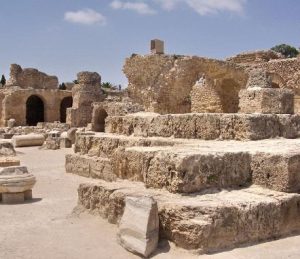
825 – 820 BC
It is claimed that the city was founded under the name of Qart Hadasht, i.e., New Town.
247 BC
The birth of Hannibal Barca, known as Hannibal, was considered by many as one of the greatest military strategists in history.
The territories controlled by Carthage changed it into a capital of a prosperous republic, enriching it with resources from all the Western Mediterranean. Carthage was, during a long period, a city more prosperous and wealthy than Rome. During its greatest peak, it reached 400,000 inhabitants, buildings that stood 6 or 7 stories tall, a unified sewage system, and dozens of public baths.
146 BC
The Carthaginian Republic faced the Roman Republic for dominance in the Western Mediterranean and was defeated. This lead to the disappearance of the Carthaginian state and the destruction of the city of Carthage.
29 BC
Octavian founded in its place the Roman colony Julian Carthage, which became the capital of the Roman province in Africa, one of the most important producers of grain in the empire.
425
The Vandals (German people) conquered Carthage.
534
Carthage was retaken by Byzantium.
705
A Muslim attack devastated the city reducing it to ashes and massacring all of its inhabitants Since then, it remained dominated by Islam.
1270
On its ruins, the Eighth Crusade took place.
Ancient Phoenicia

There never existed a country called “Phoenicia”. Phoenicia refers to a group of independent cities that were more interested in trade than building an empire. The five most important cities of Eastern Phoenicia were: Arados, Byblos, Birutos (Modern day Beirut), Tyre, and Sidon. Each of these cities made up a small independent state. The name Phoenicia comes from the Greeks. The Greek term “Phoenix” is first found in the works of Homer and means purple. “The Purple People”, they called them, for being the inventors of a dye extracted from the murex mollusk, abundant on the coasts of Phoenicia.
Since then, people assumed intermediary roles between distant countries, between the ancient Eastern culture and the Western.
Phoenicia is the name of an ancient region of the Middle East, cradle of the Phoenician and Canaanite civilizations, which extended along the eastern coast of the Mediterranean. They coincided with the Canaanite people of the bible. Phoenicia was, for being an important center of trade, coveted by large neighboring empires.
The Phoenicians were the inventors of the alphabet. It was a simple system that permitted the diffusion of knowledge and culture. The Phoenician alphabet was adopted and modified by the Greeks to represent their language. The Latin alphabet came from the Etruscan alphabet, which was, in turn, an adaptation of the Greek alphabet.
The first god of the Phoenicians was Astarte, the goddess of fertility. She was assimilated into other cultures with different names like the Greek goddess Aphrodite and the Roman god Venus and the Egyptian god Isis.
Baal was a god (possibly of the son) of various peoples from Asia Minor and those influenced by Asia Minor. In the Bible, Baal is one of the false gods, to which the Hebrews ran to when they fell away from their adoration for Yahweh.
4000 BC
A group of Canaanite men, of semitic race and language and coming from the Persian or Arabic gulf established themselves on the northern coasts of Lebanese Syria.
1200-1100 BC
The Canaanite people of the coast start to become known as Phoenicians.
1000-700 BC
Eastern Phoenicia established commercial routes and colonies in the Mediterranean.
820 BC
Pygmalion rose to the throne to the age of eleven, under the regency of the great priest Melkart who was married to Dido, sister of the king who had to escape to Africa when she attempted to avenge the death of her husband. In Africa, she bought a piece of land on the cast from the Libyan king Jarbas where she founded Carthage, a city that very shortly after would inherit the maritime and trade supremacy of the Phoenician world.
600 BC
The Carthaginians were allied with the Etruscans against the Greeks.
494 BC
The Phoenicians began to help the Persians against the Greeks in a 14-year naval campaign.
480 BC
The Greeks won against the Persians, who fought with the help of the Phoenician Navy. The Carthaginian armada was also defeated.
332 BC
Tyre is sieged by Alexander the Great. Hence the end of Eastern Phoenicia.
264 BC – 241 BC
First Punic War between Rome and Carthage.
221 BC
Hannibal the Great rises to the throne.
218 BC
The Second Punic War begins. Hannibal manages to cross the Alps to fight the Romans.
146 BC
The Third Punic War ends. Carthage falls. Hence the end of Western Phoenicia.
64 BC
By this date, the Phoenician cities had adopted Greek culture and the name Phoenicia had disappeared. Carthage was put in charge of the supremacy of the Phoenician world.
Hebrew – Ancient Hebrew Civilization
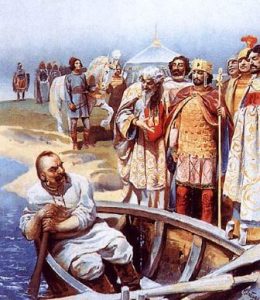
The terms “Hebrew” and “Israelite” often describe the same people. They were called Hebrews before the conquest of the land of Canaan and Israelites afterwards.
The Hebrews were an ancient Semite people from the Middle East and they were ancestors of the Israelites and the original Jews of Mesopotamia. They were nomads, living in tents, bringing herds of goats and sheep, utilizing donkeys, mules, and camels as their luggage carriers. A distinctive feature was their conviction in the existence of a single god, called Yahweh.
2000 BC – 1500 BC
Patriarchies; Abraham, his son Isaac, and his grandson Jacob.
1300 BC
The Exodus from Egypt. They wandered for 40 years through the Sinai desert, where they formed a nation.
12th Century – 10th Century BC
The Israelites conquered a great part of the Land, they abandoned their nomadic customs and transformed into farmers and craftsmen.
1020 BC
Saul, first king of the Jews.
1004 BC – 965 BC
King David (1004 – 965 BC) changed Israel into an important power in the region through his successful military expeditions, seeing to the final defeat of the Philistines.
1000 BC
Jerusalem becomes the capital of the reign of David.
965 BC – 930 BC
Solomon brought Israel to match the power of the other great kingdoms of its time.
930 BC
The kingdom is divided in two: Judea and Israel.
720 BC
Israel is won over by the Assyrians.
586 BC
Babylonia conquers Judea. Jerusalem and the First Temple are destroyed, the majority of the Jews are exiled to Babylonia.
332 BC
The Land is conquered by Alexander the Great; Hellenistic Ruler.
63 BC
Jerusalem is captured by the great Roman general Pompeo.
37 BC – 4 AD
Herod, Roman vassal king, governs the Land of Israel. The Temple in Jerusalem is reconstructed.
20 AD – 33 AD
The Ministry of Jesus of Nazareth.
66 AD
Judea’s rebellion against Rome
636 AD – 1099 AD
Persian Rule
1099 AD – 1291 AD
Latin reign over Jerusalem
1291 AD – 1516 AD
Mameluke Rule
1517 AD – 1917 AD
Ottoman Rule
Numidia
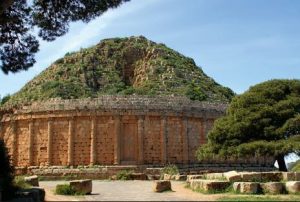
Numidia was constituted after the Second Punic War. Located in North Africa, around modern-day Morocco, Algeria, and Libya.
The name “Numidia” comes from the Greek word for “Nomad”. They felt great passion for horses and they had a strong reputation as riders; as such, they served in the Carthaginian armies. Numidia provided part of the highest quality Calvary in the Second Punic War, and the Numidian Calvary had a main role in a series of battles. Both were initially in support of Hannibal before the war before switching alliances and siding with the Roman Republic.
The Numidians were one of the first natives that traded with the Carthaginian colonies. As Carthage grew, the relations with the Numidians flourished.
650 BC
The Phoenicians arrived on the coasts of Mauritania and Numidia.
202 BC – 46 BC
The Numidian Golden Age
20 BC
Numidia was integrated into the Roman Empire as a province.
Crete
Crete is an island situated in the Aegean Sea. The largest Greek island and the fifth in size in the Mediterranean.
1600 BC – 1400 BC
Crete reached its greatest peak as part of the Minoan Civilization.
1400 BC
The Island suffered the invasion of the Achaeans. With the expansion from the invaders, various cities were founded on the southern coast of Canaan: Gaza, Asdod, Ecrón, Ascalón and Gat.
1000 BC
The invasion of the Dorians, who utilized iron. Crete came to be part of the Greek world.
67 BC
In an expedition commanded by Cecilio Metelo, Crete was added to the Roman empire.
395 AD
Fell into the hands of the East Roman Empire, or Byzantium.
826 AD – 961 AD
In the hands of a group of Andalusian Muslims.
1204 AD
Under the rule of the Latin Empire, Crete is given to Venice. Venice uses Crete as a strategic point from which to carry out their interests in the Eastern Mediterranean. Venice possessed Crete until the middle of the XVII century.
Muslim Empire
The followers of Islam are called Muslims (All of those who accept the will of a god)
570 AD
Year of the Elephant, Muhammed is born in Mecca.
610 AD
Muhammed begins to preach a new, monotheistic religion: Islam.
622 AD
Muhammed and many of his followers flee to the neighboring city of Medina. This migration is called the Hegira. It was the first year of the reign of Muhammed as a secular governor as well as a religious leader. Following the customs of the time, historians later marked that year as the start of the Muslim calendar.
629 AD
Muhammed moved towards Mecca with 10,000 men and the battle was won without a single drop of blood.
632 AD
The prophet dies at the age of 63 in the city of Medina.
634 AD – 644 AD
They conquered Mesopotamia, Persia, Palestinian Egypt, Syria, and North Africa.
Timeline of Ancient Civilizations in Europe
Greece – Ancient Greek Civilization
7000 BC

The first groups settle in Crete, probably coming from Anatolia.
2600 BC – 2000 BC
Ancient Minoan or Prepalatial: Growth and expansion of trade in Crete with countries in the Middle East and Egypt.
Their economy transformed from agricultural to a higher-level of organization because of trade with foreign countries.
The pottery wheel is introduced and they begin bronze metallurgy.
2000 BC – 1700 BC
Middle Minoan or Protopalatial: The principal characteristics of this period are: the construction of palaces, the development of the ceramic style of Kamarés, and the appearance of literature.
Trade was strongly developed and the concept of private property was created.
The economy was based in the cultivation of wheat, vines, olives, and livestock.
1700 BC – 1350 BC
Minoan Neopalatial or New Palace Period: New cities were founded and new, more majestic palaces were constructed on the ruins of the old ones. There is improvement and development of communications over land and sea through construction of roads and ports, which allowed merchant ships to trade agricultural and artistic products for raw materials.
In the 7th century BC, all of the Neopalatial centers are destroyed due to the eruption of the volcano of Santorini (Minoan Eruption).
1700 BC
Invasion by the Hittites from Anatolia (modern-day Turkey). Palaces were reconstructed and a great period of growth begins in the civilization.
1350 BC – 1100 BC
Minoan Postpalatial: Construction of the legendary palace of the mythological king Idomeneo. Marked with a tendency towards architecture and stylization. This is the period of the famous poems of Homer, the Iliad and the Odyssey.
Mycenaeans
They get their name from the village of Mycenae in Peloponnese. It is believed to be the world described by Homer in the Iliad and the Odyssey. Its position was fixed during the Bronze Age of the Aegean world.
The translation of the Linear B tablets shows that the improperly called Mycenaeans are really Greeks.
1550 BC – 1500 BC
The Recent Helladic Period I: The cultural characteristics of the Mycenaean civilization were built in this period.
1500 BC – 1425 BC
The Recent Helladic Period II: The Mycenaean palaces are destroyed. Only the archeological site of Knossos is reconstructed to show a Mycenaean who invaded Crete and took power.
1425 BC – 1110 BC
The Recent Helladic Period III: This period built the peak of the Mycenaean civilization. The civilization was expanded. As well as Crete, other islands of the Aegean Sea (Cyclades and Rhodes) and places in Asia Minor show Mycenaean deposits.
Ancient Greece
This refers to the period of Greek history from the Dark Age (1100 BC) and the Doric Invasion until the year 146 BC and the Roman conquest of Greece after the battle of Corinth. The Ancient Greeks are considered a seminal culture that served as the basis for western civilization. Their culture had a powerful influence over the Roman Empire, who disseminated into many European territories. The Greek culture gave rise to the renaissance of the 15th and 16th centuries in Western Europe and the neoclassical movements in Europe and America in the 18th and 19th centuries.
After the Mycenaean and Minoan civilizations, in the dark centuries (between the 13th and 12th centuries BC) the existing fragmentation in the Hellas will make a framework through which small, organized, political centers will develop into cities. The Polis were the true political unit, with their institutions, customs, and laws. They were constituted as the identifying element of an era. Greece would give Alexander the Great a path to construct an empire, overtaking the Archaemenids and Egyptians.
1100 BC – 750 BC
Dark Age: Signs of geometric designs on pottery. No written texts survived from this era. There is very little archaeological evidence.
750 BC – 500 BC
Archaic Era: In the beginning, the people were illiterate. They created the Greek alphabet based on the Phoenician alphabet. The artists created sculptures in stretched positions with a dreamlike “archaic smile”.
500 BC – 323 BC
Classical Period: They created a style that was later considered exemplary. The Parthenon was constructed during this period.
431 BC – 401 BC
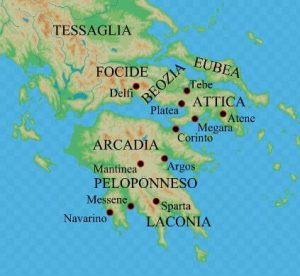
Greece falls again during the Peloponnesian wars were Sparta defeated Athens.
338 BC
Philip of Macedonia united the Greeks by force, paving the road for his son Alexander the Great.
323 BC – 146 BC
Hellenistic Period: This is when the culture and power of Greece extended through the Middle East and the Near East and started with the death of Alexander the Great.
146 BC – 330 AD
Roman Greece: Since the Roman conquest until the establishment of the city of Byzantium (renamed Constantinople in 330 AD), modern-day Istanbul.
330 AD – 529 AD
Late Antiquity: characterized by the decline of Roman polytheism facing the advance of Christianity. This is usually symbolized by the closing of the Academy of Athens by Justinian I, as well as the prohibition of all religions other than Christianity.
There is an invasion of the Germanic and Slavic people. They were established in the mountains are were Hellenized.
626 AD
The Avars were allied with the Persians and laid siege against Constantinople but were forced to withdraw due to a strong resistance from the inhabitants.
628 AD
The peace between Persia and Byzantium forced the Persians to return conquered territories.
632 AD
The Arabic raids against the Byzantines begin.
635 AD
The Arabs occupy Damascus.
10th century
The emperors manage to stop the advance of the Arabs in the south and the Bulgarians in the north.
11th and 12th centuries
The constant attacks from Norsemen forces the emperors to solicit support from the Republic of Venice in exchange for a series of trade benefits.
1202 AD – 1261 AD
The Fourth Crusade, which began with the retaking of the Holy Land, changed course and ended with the conquest of Constantinople, capital of the Byzantine Empire, called “Romaniae Empire” (in Latin). Thus the “Eastern Latin Empire” was founded.
1204 AD – 1261 AD
Greece was divided into a series of principalities controlled by French nobles.
It should be noted that, until its fall, Greece developed an excellent fleet of which the Dromon is the ship that stood out the most. It was armed with a weapon that was used exclusively by the Greeks, the Greek Fire. It was shot from a canon of bronze like a flamethrower.
Romans – Ancient Rome
Roman Monarchy
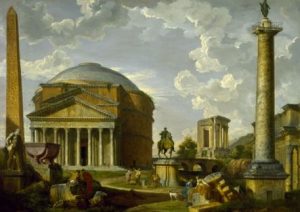
This was the first form of government in the city-state, Rome. From the moment of its legendary founding in 753 BC until the end of the monarchy in 509 BC, it paved the way for the Roman Republic.
The origin of the city of Rome can be placed especially close to Palatine Hill, next to the Tiber river, in a point in which a natural ford permitted crossing. It was also navigable from the sea (located 25km downstream) uniquely from this position; it was also an intersection of interest in the commercial routes from Central Lazio, and in between Etruria and Campania. These factors were what largely contributed to the success and the strength of the city.
21st of April, 753 BC
The city of Rome was founded. Romulo was the first king. This was the year 0 in the Roman calendar.
717 BC
Romulo died
715 BC – 676 BC
Numa Pomilio is the second king of Rome. He reformed the calendar, adjusting it for the solar and years, adding also the months of January and February to complete the 12-month calendar.
578 BC – 535 BC
Servio Tulio is the sixth king of Rome. The first census in the world is attributed to him.
Roman Republic
The Roman Republic was a period of Roman history characterized by the Republican regime as a form of government. This was in practice since 509 BC when the monarchy was put to an end with the expulsion of the last king, Lucio Tarquino the arrogant, until 27 AD, the date in which Rome became an empire.
509 BC
Rome was equipped with a new system of government designed to replace the leadership of the kings. The new position of Consul was created, assigned explicitly to two senators. Initially, the Consuls possessed all the powers of the king, but shared between the two of them. Their mandates were annual and each Consul could veto the actions or decisions of the other.
504 BC
The Republic was born with the expulsion of the Roman Monarchy.
498 BC – 493 BC
The First Latin War: The Romans wanted to consolidate their power in Lazio. The decisive battle ended next to the Regilo Lake with a Roman victory.
340 BC – 338 BC
The Second Latin War occurred a century and a half after the first. Rome and its allies, the Samnites, defeated the Latin tribes and the people of Campania in the battle of Vesuvius. With this victory, the Latin tribes evacuated Campania until they were integrated into the Roman Republic.
264 BC – 146 BC
A series of three wars between the two main powers of the Mediterranean at the time: Rome and Carthage. The main cause was the domination of commercial interests in the Mediterranean Sea.
60 BC – 53 BC
First Roman triumvirate: Unofficial political alliance formed by Gnaeus Pompey Magnus, Gaius Julius Caesar, and Marcus Crassus Licino, who abolished the aristocratic constitution.
31 BC
The Roman Senate, controlled by Octavius, declared that Mark Antony was not useful for the second triumvirate and declared war with Cleopatra. In the battle of Actium, Octavius defeated Mark Antony and Cleopatra who killed themselves soon after. Thus, Octavius was given the title of Augustus and became the first emperor of Rome.
Roman Empire
The Roman Empire was characterized by an autocratic form of government (absolute power of one single person). They reached their greatest extension with Trajan, ranging from the Atlantic Ocean in the west to the shores of the Caspian sea, Red sea, and Persian Gulf in the east and from the Sahara Desert in the south to the coasts of the Rhine and Danube rivers and the frontiers of Caledonia (Ancient Scotland) in the north.
31 BC – 14 AD
Cesar Augusto. With the victory of Octavius against Mark Antony, the Republic annexed the great riches of Egypt.
27 BC
The senate granted the title of Emperor Caesar Augustus, which made him commander of all the armies. After his death, Octavius was consecrated as a son of Divus (divine) Julius Cesar, which would turn him, in death, into a god.
14 AD – 69 AD
Julius Dynasty – Claudiana: The successors of Augustus demonstrated the weaknesses of a hereditary dynastic system. Tiberius, Caligula, and Nero were especially despotic, they were also driven by excessive madness that put to the test the strength of the consolidated system from Octavius’s wise management.
69 AD – 96 AD
Flavian Dynasty
69 AD – 79 AD
Vespasian: highlights of his reign include financial reforms that he promoted After the fall of the Julio-Claudia Dynasty, his successful campaign in Judea and his ambitious construction projects like the Flavian Amphitheater, known popularly as the Roman Colosseum were quite necessary.
79 AD – 81 AD
Tito: Son of Vespasian: Reached popularity as a military commander to serve the orders of his father in Judea, during the conflict known as the First Judeo-Roman War (67 AD – 70 AD). He burned Jerusalem whose temple was destroyed. He also completed the Flavian Amphitheater, commonly known as the Colosseum.
96 AD – 192 AD
The Antonios dynasty: their first five emperors were known as the Dynasty of the Five Good Emperors because all of them were wise and lead Rome well. Thanks to a new system of succession based on the appointment of the successor instead of depending on the next-of-kin. It also ensured a good sequence of leaders until Marcus Aurelius broke the rule, designating his son, Comodo, a decision that would be disastrous.
193 AD – 235 AD
Severan Dynasty
235 AD – 284 AD
Crisis of the 3rd century. At the end of the Severan dynasty, the third anarchy began and from this, several emperors come to power thanks to having risen from military command by merits without necessarily being from a noble family. The first emperor of this new era is Maximinus the Thracian, son of peasants and from modern-day Bulgaria.
284 AD – 304 AD
The establishment of the tetrarchy (Shared power between four tetrarchs). This was instituted by the Roman Emperor Diocletian, whom appointed Maximian Augustus of the West. The two Augustus named the two Caesars simultaneously: Galerius and Constantius Chlorus, who supported the two Augustus and replaced them in the case of incapacity to lead or death. In this system, at least in the first tetrarch, there wasn’t a territorial division that perfectly delineated the powers of each tetrarch. Diocletian behaved as though he held superior power for being the last Augustus. Given that this situation was not the case for the second tetrarchy and since there were already problems of supremacy being generated, the territorial division between the four leaders was completed in the second tetrarchy. It was determined that the Augustuses should step down after 20 years of governing, leaving the two Caesers the task of selecting new ones.
380 AD
Flavio Theodosius declared Catholic Christianity as the only legitimate imperial religion imperial, ending the traditional Roman religion with the support of the State.
395 AD
After his death, the previous Emperor that governed all of the Roman Empire, Flavio Theodosius, split the kingdom amongst his children: Arcadio received the Eastern Empire, consisting of the Balcan Peninsula, Anatolia, the Middle East, and Egypt which came to be called the Byzantine Empire. Honorius received the west that consisted of Italy, Hispania, Gaul, the island of Great Britain (Britannia), the Maghreb, and the coasts of Libya.
Western Roman Empire
451 AD
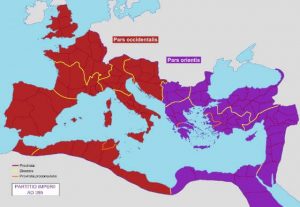
The king Attila the Hun marched against Rome. The Roman general Flavio Aecio, known as “’The Last Great Roman”, marched towards the border and in the Battle of the Catalaunian Plains he defeated the once invincible Attila.
452 AD
Attila threw a powerful counterattack that was carried to the very gates of Rome. There, Pope Leon I met in secret with him, and after this, Attila ordered the withdrawal of his troops without explanation. To this day, no one knows what happened between them, though it is probable that Attila withdrew his troops due to the hunger and sickness that his military was suffering through and that would impede his ability to maintain a siege against Rome.
476 AD
The last emperor of the west, Romulo Augustulo, who was only a boy. After this emperor was defeated by a barbarian leader named Odoacro, the Western Roman Empire disappeared and gave way to the middle ages.
Eastern Roman Empire
The original Greek name was Romania or Basileia Romanion : Roman Empire, direct translation of the name in Latin, Imperium Romanorum. It was named “The Greek Empire” by its Western European contemporaries (due to the dominance of Greek language, culture, and ethnicity). In the Islamic world, it was known as Rûm (Land of the Romans) and its inhabitants were known as Rumis.
The capital of this Christian Empire was in Constantinople (Istanbul). Its ancient name, Byzantium, inspired the term Byzantine Empire by the illustrated erudition of the 17th and 18th centuries.
While it is a continuation of the Eastern Roman Empire, its transformation into a separate cultural entity can be seen as a process that started when Emperor Constantine I moved the capital to ancient Byzantium (which was then renamed New Rome); he continued with the definitive splitting of the Roman Empire into two parts after the death of Theodosius I in 395 AD and the subsequent disappearance in 476 AD of the Western Roman Empire.
628 AD
Heraclius took the title of King of Kings and abandoned the imperial title of Augustus, whose reforms (above all, the reorganization of the army and the adoption of Greek as the official language), the empire acquired a character starkly different from the old Roman Empire.
641 AD
Under the reign of Constantine II, the Roman Empire lost Egypt, which was conquered by the Arabs.
674 AD
Constantine IV defeated the Arab fleet by using Greek Fire for the first time.
681 AD
Constantine recognized the Bulgarian Empire’s existence after suffering a disastrous defeat while trying to move them out of the Balcans.
698 AD – 705 AD
Under the reign of Emperor Tiberius III, the Byzantine Empire let go of Africa, which he considered a lost province.
1054 AD
The secular differences between the Greek Orthodox Church and the Roman Catholic Church lead to their definitive separation.
Macedonian Empire
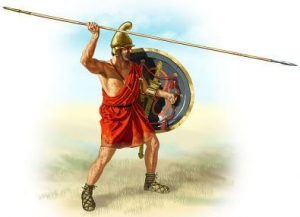
This kingdom was consolidated during the 5th century (730 BC) and experienced an important increase in power during the 4th century BC with the government of Philip II, who changed Macedonia into the main power in Greece. His son, Alexander the Great conquered most of the known world, inaugurating the Hellenistic Period of Greek history.
Macedonia was divided into two large regions, Higher and Lower Macedonia. It had reduced coastlines.
With the arrival of Phillip II they achieved great success. He expanded the territory to Lake Ohrid.
357 BC – 355 BC
Social war. In 357 he took the Athenian colony of Amphipolis which controlled the gold mines.
Alexander, son of Phillip II, finished his father’s last project, conquer the Persian Empire.
First Macedonian War
214 BC – 205 BC
It began as a consequence of the rapprochement between Phillip V of Macedonia and Hannibal. Unstable peace was negotiated that allowed Rome to concentrate its energy on defeated Carthage.
Second Macedonian War
200 BC
Rome asked Macedonia to withdraw from Greece. The king of Macedonia was defeated and forced to sign a peace treaty that abandoned their claims on Greece.
Third Macedonian War
171 BC – 168 BC
It was between Rome and King Perseus of Macedonia. Perseus won and offered the Romans a peace treaty that was rejected.
281 BC
The empire was divided into three large states.
768 AD
Alexander the Great was the Emperor. Charlemagne reestablished the balance in power between emperor and the pope.
772 AD
Charlemagne undertook a long war in which he defeated and conquered the Saxons and incorporated their territories into the French Empire.
782 AD
Charlemagne was the battle and ordered the slaughter of thousands of pagan Saxon prisoners.
773 AD – 774 AD
Charlemagne conquered the Lombards
800 AD
Christmas day, Pope Leon III coronated Charlemagne as emperor over the Roman Empire.
28th of January, 814 AD
Charlemagne died in Aachen.
Barbarian Invasion
Among the invading German people are the Goths, divided into the Visigoths in the west and the Ostrogoths in the east. The French, the Swabians, the Burgundians, the Anglos, the Saxons, and the Jutes, the Vandals, the Frisians, the Alans (Iranian), and the Germans constituted the rest of the people.
All of the barbarian kings adopted Catholicism.
Written law was adopted.
235 AD – 285 AD
Rome was immersed into a period of anarchy and civil war.
500 AD
Theodoric, king of the Ostrogoths, drafted the first collection of laws.
The Huns

They were a nomadic people from the area of Mongolia and Central Asia. They started to emigrate towards the west in the 3rd century under the command of Attila.
By their skill and military discipline, no one was able to stop them. They displaced everyone in their path. They provoked a wave of migration for people who wanted to leave before the Huns arrived.
The invasions provoked the paralysis of trade and industry, the destruction of the Western Roman Empire, that is to say, the end of an established, advanced civilization, and also the beginning of a new European Era, the Middle Ages.
Timeline of Ancient Civilziations in the Americas
Cultures of Mesoamerica
Mesoamerica is the region of the American continent that includes the southern half of Mexico, the Guatemalan territories, El Salvador, and Belize, as well as Western Honduras, Nicaragua, and Costa Rica.
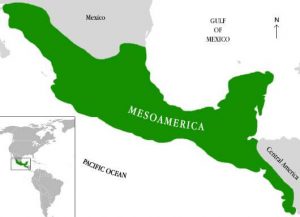
Mesoamerica is an area defined by the culture. This region saw the development of an indigenous civilization in the frame of a mosaic of great ethnic and linguistic diversity. The agricultural base of the economy, the sedentarism, the use of the planting pipe, the cultivation of corn and nixtamalization, the ball game, the use of two calendars (260-day ritual calendar and 365-day civil calendar), the human sacrifices as part of religious expression, the number system to base 20, the lithic technology, and the absence of metallurgy, amongst others are characteristic features of the Mesoamerican Culture. Throughout their history, the Mesoamerican people constructed a civilization whose expressions spoke of shared elements between various people and features that distinguished between them.
One of the great mathematical contributions, above all from the Mexicans, was the invention of the Nepohualtzintzin which is an abacus used for carrying out arithmetic operations quickly. The device, built from wood, wire, and grains of corn, is also known as the “Aztecan computer”. The Mayans were the first civilization of Mesoamerica and of many other nations that had zero has a mathematical concept.
500 BC
Domestication of corn, probably from the teosinte.
2500 BC – 2600 BC
Full sedentarization begins. From this era come the most ancient ceramic vestiges of Mesoamerica found in Port Vallarta, Gro. And in Tehuacan, Pue.
1200 BC
A 260-day calendar is used as a civil calendar.
25th century – 12 century BC
Early Preclassic period: the manufacturing of ceramics is generalized throughout the whole region; the cultivation of maize and other vegetables is consolidated and the process of social stratification began that concluded with the appearance of the first stratified societies on the coast of the Gulf of Mexico and the Guatemalan Pacific.
12th Century – 4th century BC
The Middle Preclassic period: The Capachan culture (in Colima) was an important engine in the process of civilizing Mesoamerica, and their pottery diffused widely. In this era, the first writing systems were developed along with the base-20 numerical system of the Olmecs.
4th century BC – 2nd century AD
Late Preclassic Period: Around Lake Texcoco are several villages that will become great cities, like Tlatilco and Cuicuilco. This is the era that the circular pyramid of Cuicuilco, the central square of Monte Alban, and the pyramid of the moon in Teotihuacan are estimated to have been built.
Olmeca

This culture developed in Mesoamerica during the Middle Preclassic Period. The central area of Olmeca, or metropolitan area, extended to the southeastern part of the state of Veracruz and the western part of Tabasco. They are considered to be the mother culture of Mesoamerican civilization.
Even though the origin of the Olmec culture is not known, the network of trade between distinct areas of Mesoamerica contributes to the diffusion of many cultural elements that are associated with the Olmec culture, including the worship of mountains and caves, the worship of the Feathered Serpent as a deity associated with agriculture, the religious symbolism of jade and also their own artistic style that was reworked intensely in the following centuries to the decline of major centers of this society.
1200 BC
The oldest beginnings of the Olmecans.
1150 BC
The oldest registered Olmec Center is San Lorenzo, located in the basin of the Coatzacoalcos River, in the State of Veracruz. This is the date that most of the sculptures and architectural elements that characterize the Olmec culture were made.
900 BC – 400 BC
La Venta is the main archaeological site of the Olmecan culture. It developed on an island on the border of Tabasco and Veracruz. The most important structure of La Venta is the pyramid constructed with accumulated mud.
32 BC
Tres Zapotes. There is confusion about the timeframe that this ceremonial center was occupied; however, it is known to be the last to develop. It is the most well known because it survived until the nearest era, but the Olmecan civilization that developed here was a culture already in decline, not the flourishing culture that lived in previous ceremonial centers. This period is characterized by the marked decline of the Olmecans and the reflection of the culture’s influence in tow other cultures: the Teotihuacanans and the Mayans.
Zapoteca
In the Precolumbian Era, the Zapotecans were one of the most important civilizations of Mesoamerica. They historically occupied the south part of Oaxaca and the isthmus of Tehuantepec (Mexico).
500 BC – 400 BC
The history of Monte Alban begins.
200 BC – 750 AD
An era of great splendor for this civilization.
0 – 200 AD
The Zapotecans begin to abandon Monte Alban and occupy Mitla.
500 AD – 800 AD
The Zapotecans completely abandon Monte Alban after they break relations with Teotihuacan.
750 AD – 1200 AD
Decline of the Zapotecans by the domination of the Mixtecans.
Tarasca
The Tarascan Culture is a Precolombian culture from Mexico that flourished mainly in the eastern region of the state of Michoacan. The word “Tarasco” seems to be a term of kinship that was used by the ancient Purepechas towards certain Spaniards with whom they were related through political marriage. Tarasco comes from the word tarascue (my son-in-law or my father-in-law), used by the indigenous people to refer to the first Spaniards. They currently call themselves P’urepechans, which derives from the way that the social and cultural classes of the workers and warriors were referenced.
They dedicated themselves to pottery, sculpting, architecture, painting, goldsmithing, and notably fishing, which was and continues to be the primary activity of the P’urepechans. They were also the only ones that were able to work with bronze, as it was one of their secret trades.
1200 AD
The Tarasca culture began. Irititicame decided that they would establish themselves in the modern state of Michoacan, Mexico, and conquer the neighboring people of Naraxan.
Mixteca

The historical territory of the Mixtecans is the area known today as Mixteca, divided between the Mexican states of Puebla, Oaxaca, and Guerrero. The Mixtecans shared numerous cultural features with their neighbors, the Zapotecans. In fact, both peoples called themselves people of the rain or people of the clouds.
1500 BC
The first agricultural settlements in the region appeared.
900 BC – 500 BC
Settlements started to appear that would reach peak populations of thousands of people. Amongst them is Monte Negro and Huamelulpan.
1st Century – 9th Century
Large, highly-populated cities appear with a clear specialization in the use of space and social differentiation. The cultural influence of Teotihuacana was felt throughout the region. The Mixtecans were organized in small city-states that rarely exceeded 12 thousand people.
1063 AD – 1115 AD
Ocho Venado – Garra de Jaguar (Tilantongo) successfully conquered around 100 Mixtecan estates. In addition, he established an important network of alliances through his marriages. Though this era, the Mixtecans were one of the region’s most prosperous civilizations in Mesoamerica. They exported large luxury items to other regions, like polychromatic ceramics, feather art, silverware, carvings in rock crystal, bone, and wood; as well as subsistence goods, which were typical of the tropics and temperate zones.
Unlike what happened in Central Mexico, most of the Mixtecans established agreements with the Spaniards and a mutual adaptation of culture arose that in time allowed for the Mixtecans to retain several of their traditions and customs such as their language, business practices, agricultural methods etc. Only some parts of the Mixtecans resisted with military force to the Spaniard conquest like Tututepec.
Teotihuacan
Strategically located to the north east of the Mexican Valley, in the vicinity of the northern shore of Lake Texcoco, Teotihuacan became the main competition for Cuicuilco during the Late Preclassic Period.
Its original name and the ethnic group that founded it are not known. Teotihuacan (nahuatl: Teotihuacan, “Place where the gods were made”) is the name given by the Mexicans to the remains of the ancient urban center that reached its peak during the Early Classic Period.
The expansion of Teotihuacan wasn’t achieved alone with weapons, but through a combination of military activity, trade, and the establishment of political alliances. Amongst the main products monopolized by the Teotihuacans was obsidian, alabaster, and the Thin Orange Ceramics.
During its golden age it influenced its neighbors and inspired other cultures as well as handed down scientific and cultural knowledge to the subsequent generations. For this reason, it is very common to find traces and evidence of this culture throughout the Mexican territory.
600 BC
First settlements in Teotihuacan.
200 BC – 200 AD
The eruption of the Xitle south of the valley quickened the fall of Cuicuilco and encouraged population growth and the expansion of political and economic power in Teotihuacan.
2nd century – 6th century
Teotihuacan’s Cultural Peak
650 AD
For unknown reasons, the gradual decline that ends in the 8th Century AD, even though the valley was never abandoned. When Teotihuacan declined, other centers that depended culturally and commercially on it came to a rapid end as well. This happened to Monte Alban and even the Mayans.
Mayan – Ancient Maya Civilization
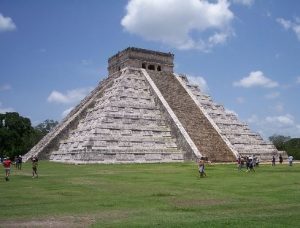
The Mayan Civilization inhabited a vast region known as Mesoamerica, in the territory today comprised of 5 states to the southeast of Mexico. They are Campeche, Quintana Roo, Tabasco, and Yucatan; and in Central America, in the modern-day territories of Belize, Guatemala, Honduras, and El Salvador.
The Spaniard Conquest of the Mayan people was completed in 1697, with the conquering of Tayasal, capital of the Itza and Zacpeten Mayans, capital of the Ko’woj Mayans was in Peten (Modern-day Guatemala). The last Mayan state disappeared when the Mexican government of Porfirio Diaz occupied their capital in 1901, Chan Santa Cruz (Modern-day Felipe Carrillo Puero, Quintana Roo), giving an end to the so-called Caste War.
1200 BC
A theory based on studies of their pottery suggests that a branch of the Mayans may have migrated to the Gulf and developed the Olmec civilization.
200 AD
Some groups emigrate from Peten toward the North (Yucatan Peninsula).
400 AD
Invasion of the Teotihuacans whose military and cultural influence was felt since then in the entire Mayan kingdom.
320 AD – 927 AD
Theocratic Period. The image of the Mayans as a society governed by priests was knocked down when it was discovered that the cities were in constant war with each other.
The most well-known archaeological sites from this period are: Tikal, Uaxactún, Piedras Negras, Cancuén, Caracol, Yaxhá, Naranjo, Xultún, Río Azul, Naachtún, Dos Pilas, Machaquilá, Aguateca, Comalcalco, Palenque, Yaxchilán, Kankí, Bonampak, Quiriguá , Tulum, Edzná, Oxkintoko, Ceibal, Xamantún, Copán, San Andrés, Yaaxcanah, Cobá, El Cedral, Ichpaatún, Kantunilkín, Kuc (Chancah), Kucicano, Tazumal, Las Moras, Mario Ancona, Muyil, Oxlakmul, Oxtancah, Oxhindzonot, Pasión de Cristo, Río Indio, San Antonio III, Nahuo Punta Pájaros, San Manuel, San Miguel, Punta Molas, Tamalcab, Templo de las Higueras, Tupack, Xlahpak, Tzibanché y Kohunlich.
600 BC – 889 AD
Uaxactun has the oldest Mayan temple ever found in the region and it is the first place were the existence of the false tomb was observed.
800 BC – 869 AD
Tikal shows great Teotihuacan influence.
623 AD
Coba in Quintana is the oldest theocratic center in the northeast of the Yucatan Peninsula.
736 AD
Copan was the scientific center of the Mayan world, where astronomy was perfected to the point of being able to determine the length of the tropical year, create tablets of eclipses, and create a formula to adjust the calendar, even more exact than is used today.
5th century – 7th century
Teotihuacan controlled the Mayan centers of this period through war and political dominance, but above all through cultural influences and access to a variety of natural resources like cacao, which was a basic good in trade networks.
Mexican

Settled on a small island to the west of Lake Texcoco, The Mexicans- called Aztecs- were an indigenous people of Nahua affiliation, who founded Mexico – Tenochtitlan on which the currently sits Mexico City. Allied with other people of the lake basin in Mexico Valley, Tlacopan and Texcoco, the Mexicans subdued several indigenous peoples that settled into territorial groups in the center and in the south of modern-day Mexico in Altepetl (established near water).
Together with the Mayans they are the most studied theme of Mesoamerican history.
The Mexican mythology, being very diverse but practically made under the mandate of Tlacelel, originated in Chicomoztoc (nahuatl: Chicome-oztotli-co, “Place of the seven caves”), a site related to Aztlan, from where the word Aztec is derived.
12th century
Tollan (Tula) disintegrates, giving rise to a dispersion of Toltecan-Chichimecan groups towards Cholula where they defeated the Olmecans. They invaded Xochimilco. All of this created alliances both to defend themselves against conquest and for major processes of ethnic interrelations.
12th century – 14th century
The Mexicans were the last great Chichimeca migration to the Central Highlands. The Boturini Codex lays down the official route made by the Mexicans, which included sites of Hidalgo and Mexico that were successively expelled. This time many Altepetlians already had been settled for centuries with a higher degree of civilization and assimilation of the Mesoamerican tradition, which will inspire the Mexican’s understanding.
When they arrived to the Mexican Basin the Mexicans found a complex and established political landscape, as well as the ruling of the Tepanecans from Azcapotzalco over almost all of the Altepetl. After leaving expelled from Chapultepec by the Altepetl of Azcapotzalco, Xaltocan, Culhuacan, and Xochimilco, they settled in Tizapan, in the domain of Culhuacan, which they left due to the harsh conditions and a confrontation with the Culhuacans, heading towards the region of Texcoco before choosing a small island.
1325 AD
According to what is officially accepted as historical fact, in a small island to the west of Lake Texcoco, the Mexicans founded Aztecan Mexico, Tenochtitlan, where, according to official myth, the prophecy of the eagle devouring a serpent on a cactus was fulfilled. The information codified in the documents revealed that they had already inhabited a small island since 1274 AD. The final settlement included the Azcapotzalco acceptance of Altepetl as supreme, giving tribute to them periodically and remaining obedient in general. The small island was overgrown with tulares, reeds, and rich aquatic diversity that allowed for subsistence as well as strategic military positions, even then, their first years would still be dangerous.
1430 AD
Although it is believed that the triple alliance was born in the 15th century, in reality its existence comes from previous centuries. It was the last confederation of the indigenous states of the Mexican Valley, during the Mesoamerican Postclassic Period, comprised of Mexico-Tenochtitlan, of Nahuan affiliation, Tetzcuco (Spaniardized like Texcoco) in affiliation with Acolhua and Tlacopan of Otomianan tradition after the defeat of Azcapotzalco by the three manors.
Chibchan
The Chibchan village, was more civilized than those occupying the Nuevo Reino de Granada (Colombia). The rest of the country owned a large number of nations, independent tribes, and each other. They were usually enemies and often in war, different in their origins, languages, customs, idolatrous practices and degree of barbarism. In such conditions, isolation was the nature of those peoples that, if they were in a time of peace they had some communications. They were alone with the neighboring tribes and ones even closer. There were no relations between distant provinces.
They were distinguished from all the tribes and nations surrounding them, forming a uniform society composed of small states, usually independent of each other, but united by the ties of language, beliefs, customs, and similar laws, revealing a common origin.
5500 BC – 1000 BC
The Muisca human group (what they called themselves) immigrated towards the Cundiboyacens Plateau.
1500 BC – 1200 AD
Groups of farmers arrived bringing with them ceramic traditions.
1200 AD – 1510 AD
The Tayronans, descendants of the Chibchans, reached a level of development envied by other Colombian cultures. Their knowledge of architecture, agriculture, and hydraulics gave us the image of a well-constructed and advanced nation. With comparison to some European nations, the Tayronans were very much ahead of them as well.
Moche
In general, the Moche culture had great ease in the coastal area to the north of Peru, in this area they developed in impressive form, constructing great temples that became a great part of their legacy. They were very advanced with a system of irrigation and a way to control the river with the intent to water the almost desert-like territory to the north. They were also masters of metal and gold.
300 BC – 700 AD
The Moche or Mochican culture developed, a culture of Ancient Peru.
1100 AD
The Moche culture declined rapidly with the arrival of the Chimu culture. However, their art had an influence even on the great Incan Civilization.
Incan – Ancient Incan Civilization

In the slope of the eastern basin and west of the Andes Mountains in the region where the Incans would later be located, there were Chancan villages that were engaged in agriculture.
The Incan empire was a South American State governed by the Incans that swept through the western part of the subcontinent between the 15th and 16th centuries. This was the period in which the Incan Civilization reached its highest level of organization and greatest stretch of territory, known as Tahuantinsuyo (The four joined regions), covering almost 2 million square kilometers between the Pacific Ocean and the Amazon jungle and from the vicinity of San Juan de Pasto (Colombia) in the north to the Rio Maule (Central Chile) in the south. Tahuantinsuyo was more extensive than any state of Precolombian America.
13000 BC
The first hunter-gatherer human groups arrived.
8000 BC
Horticulture developed.
4000 BC
The first societies appeared with monumental architecture.
600 AD
The Huari culture arose in the area of Ayacucho.
1250 AD
Mythical date in which Manco Capac and Mama Ocllo occupied the Cuzco Valley and they became the first Incans.
1438 AD
The Incan Empire arose.
